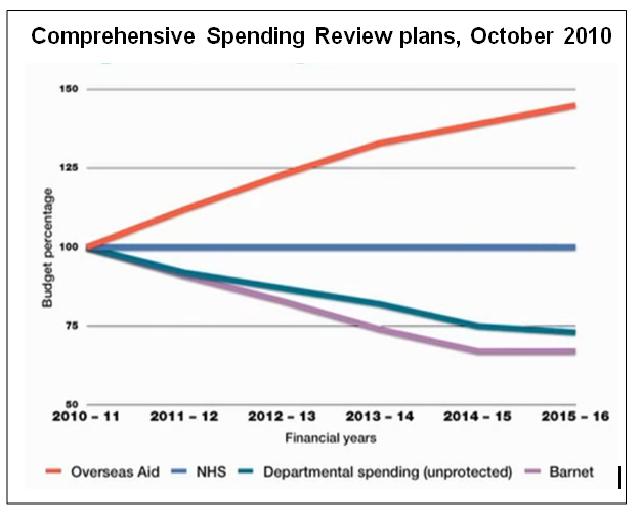Chris Game
East Cambridgeshire, East Hampshire, East Northamptonshire, South Hams, South Ribble, West Devon – anything you reckon they might have in common, apart from ‘compass point’ names that for most of us require translation to make much sense: Ely/Newmarket, Petersfield/Alton, Rushden, Totnes, Leyland, Tavistock/Okehampton, if you were wondering.
No? OK, let’s add Surrey, Cambridgeshire, Huntingdonshire, Epsom and Ewell, Tonbridge & Malling, Tunbridge Wells.
Top of the DCLG indices for least deprived local authorities? Nice try, but no cigar. No Labour-controlled London or metropolitan boroughs? Getting warmer. Conservative heartlands? Almost there. Ministers’ favourite councils? Oh dear – back to freezing, but freezing’s the clue as well as the direction of travel.
Far from being Pickles’ pets, they were on what the Daily Telegraph took to calling the ‘Roll of Shame’ – the 35 councils that decided, in the face of frequently fierce ministerial pressure, not to freeze their 2012/13 council tax rates.
They did the math, and calculated that the offer of one-off central funding equivalent to a 2.5% tax increase, but creating a potential budget gap from 2013/14, was not in their residents’ longer-term interests. So they chose to set their own budgets – insofar as these things are possible nowadays – and raise their tax rates by between 2.5 and 3.5%, the latter being the point at which a referendum and its attendant costs would have been triggered.
Unlike the previous year, when the Government’s financial incentive ran for the four-year funding term and all councils took the money and froze, this time one in ten rebelled – and the biggest single party group were, yes, 16 Conservative councils, for many of whom featuring on a naughty list must have been an interestingly novel experience.
There were, hardly surprisingly, nearly as many Labour councils – though again not those that might have been at the top of most people’s guess lists: no London boroughs, only St Helens among the mets, Leicester, Nottingham, Darlington, Stoke, Preston, Luton, York. But, with the possible exception of the three Teesside unitaries (minus Hartlepool) – Middlesbrough, Redcar & Cleveland, and Stockton-on-Tees – this was no more a co-ordinated, politically driven anti-Government protest than among the Conservative rebels.
Rather, it was councils and their finance officers doing the sums and concluding that this tax freeze offer simply did not constitute for many authorities the advantageous deal that Ministers had tried to claim – before switching their sales pitch to blustering to councillors about how freezing was a moral duty, regardless of its costs.
One of the things that will make the coming few months interesting, at least for detached observers, is that the terms of the Government’s 2013/14 tax freeze offer, announced this week, have changed once again, and can be headlined in one of those ‘Good news, bad news’ games.
This year freezers will receive a grant equivalent to just a 1% tax rise, instead of 2.5% (bad news); but they will also get an extra year’s baseline funding, “to ensure that there is no cliff-edge in funding in 2014/15” – apart, that is, from any already incurred this year (good news); but the referendum threshold comes down from a 3.5% rise to one of just 2% (bad news) – or is it?
Two observations occur to me. The first is to recall all those statements when the Conservatives were in opposition about how damaging capping was, because it took the power of decision about local spending and taxation out of the hands of local voters and handed it to remote central bureaucracies. As we enter the third year of tax freezing by ministerial arm-twisting, it’s really hard to see it as anything other than local budget setting by remote central bureaucracy.
Second, there must be a likelihood of at least a few councils seriously considering the referendum option, and making the case for restricting the speed and severity of service cuts in the general community interest – except that there seem to be so many rather substantial details still to be determined about how these referendums would actually work: the form of ballot; wording of the question(s); timing; all- or part-postal, or maybe included with annual tax demand notices; restriction to council tax payers – to name but a few.
A further non-detail, in addition of course to the cost of the whole thing, is the very principle of having a one-off referendum on a single year’s proposed tax increase, which must have the effect of making long-term planning even more difficult than it is already.
There was a question in the DCLG’s council tax referendum consultation back in 2010 that asked specifically about whether, with the abolition of capping, there was any reason why authorities should be required to calculate a budget requirement each year. The possibility of being able to frame a referendum around a medium-term financial plan, including staged council tax increases over a number of years, might be a more attractive proposition to some councils, and it’s a topic that would seem worth revisiting.
Chris is a Visiting Lecturer at INLOGOV interested in the politics of local government; local elections, electoral reform and other electoral behaviour; party politics; political leadership and management; member-officer relations; central-local relations; use of consumer and opinion research in local government; the modernisation agenda and the implementation of executive local government.








